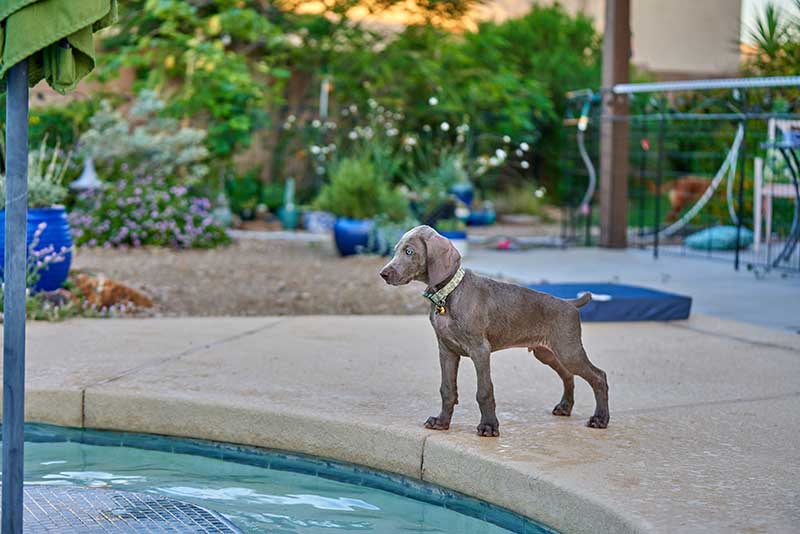In this article
Weimaraners are all-purpose gundogs bred in Germany to hunt large game, though their use evolved to small game like rabbits, foxes, and waterfowl. Along with hunting, tracking, pointing, and retrieving, the Weimaraner is a capable swimmer that can pursue game into water. They also excel at canine sports that involve swimming, such as dock diving.
Find out more about Weimaraners’ swimming ability and how to ensure your water fun is safe.

Are Weimaraners Good Swimmers?
Weimaraners are sleek, graceful dogs with the versatility to adapt to many different athletic tasks. But with their thin, short coats, some people question their ability to act as a duck dog in extreme weather conditions.
While Weimaraners aren’t ideal swimmers in extreme cold, they can excel in moderate temperatures. They’ll retrieve by hand, in or out of water, and enjoy swimming when it’s sunny and warm. They usually take to water instantly, especially if their introduction starts during puppyhood.

Important Safety Considerations
Before you attempt to teach your Weimaraner to swim, you have to take the necessary safety precautions.
If you have a puppy learning to swim or an adult learning, a doggy life jacket is a must. This will help your dog stay above water as it learns without turning the swimming lesson into a fearful experience. Most dog life jackets have a handle on the vest to lift your dog out if the situation goes sideways.
If you plan to make swimming a big part of your activities, it’s best to invest in a good quality life jacket. Follow the instructions to measure your dog for the right fit or visit a store with your dog to check them out in person.
Another consideration is blue-green algae (cyanobacteria) that occur in natural bodies of water. In 2019, there were numerous reports of dogs dying unexpectedly after swimming in areas with blue-green algae.
In many cases, the owners weren’t even aware the water had algae or that it was a risk to dogs, leading local government agencies to issue warnings and guidance. The algae can be hard to spot, so be sure to take a look at different affected water sources. If you’re not sure the water is safe, it is best to err on the side of caution.
If you think your dog has been exposed to cyanobacteria, contact a vet or an emergency clinic as soon as possible. Death can happen in as little as one hour but may take days. Early treatment offers the best outcome.
A vet will be able to advise you on the best course of action to ensure the well-being of your pet.
Did you know you can speak to a veterinarian without having to travel? Just head over to PangoVet. It's an online service where you can talk to a vet online and get the advice you need for your pet — all at an affordable price!

Also, never leave your Weimaraner to swim on its own. Even if it’s a strong swimmer, you should be actively supervising and nearby to pull your dog out if necessary.

How to Teach Your Dog to Swim
Now that we’ve covered the safety concerns, let’s dive into how you can teach your Weimaraner to swim.
Before you start, ensure that:
- Your dog has a properly fitted life jacket.
- The water isn’t too cold or too warm.
- You have rewards like toys or treats that float.
- You have a collar and leash, especially in an open body of water.
- You can rinse your dog off after swimming.

Now you’re ready to teach your dog to swim! Here’s how:
- Give your dog a sense of water as early as possible. Beaches have a shallow decline that’s perfect for introducing your dog to water gradually. If that’s not an option, the steps going into a pool or a kiddie pool are good options.
- See if your dog will go into the water on its own. You may need to help by encouraging it to step into the water first, then go deeper.
- As the water gets too deep to stand, support your puppy firmly on its sides and allow it to paddle. Once your dog gets the idea, you can turn toward the shore or edge and allow your puppy to paddle a bit on its own.
- For many dogs, swimming is instinctual, but it may take a few tries for your dog. Never rush the process, as this can create fear that’s a major setback for a future swimmer.
- Avoid getting water in your dog’s ears. This is an unpleasant experience, especially the first time. In the future, your dog may learn to ignore it.
- Once your puppy swims confidently, go a little deeper and encourage it to swim to you. Hold onto a treat as a reward.
- The next step is getting your pup to go into the water without you. Depending on what your dog likes, floatable toys or treats like cheeseballs can be a good choice. Don’t toss them out too far, but make sure your dog needs to swim a bit to get to it.
- Try to go a little farther each time, offering rewards for each attempt. Go slow so your dog feels comfortable and not stressed.
Every dog is an individual. Some Weims may get the idea very quickly while others take more time and baby steps to get there. This doesn’t necessarily mean your dog doesn’t like swimming, but just that it needs some patience and encouragement.
What If My Weim Doesn’t Like Swimming?
As a breed, Weimaraners like water, but it still comes down to the individual. Some dogs won’t enjoy swimming, which could be genetic if the parents weren’t swimmers or a result of a traumatic experience involving water.
Another possibility with an older dog is that it may not have been introduced to water early enough in its development to be a confident swimmer.
You can’t force your dog to enjoy water but you can try to introduce it to water in low-stress situations, such as wading in puddles or shallow areas of a pool. Make the experience a positive one, just like if you were dealing with a puppy, and you may find that your dog will warm up to the idea.

Conclusion
Weimaraners are excellent natural swimmers that often enjoy diving into ponds and lakes to retrieve games—or simply fetching a favorite toy from the water. While most Weimaraners like to swim, that’s not true of everyone, and it’s best to introduce your dog early (and slowly!) to make swimming a positive experience.
See also:
- Weimaraner vs. Great Dane – The Differences (With Pictures)
- How Much Exercise Does My Weimaraner Need? Vet-Reviewed FAQ
Featured Image Credit: MaCross-Photography, Shutterstock



















